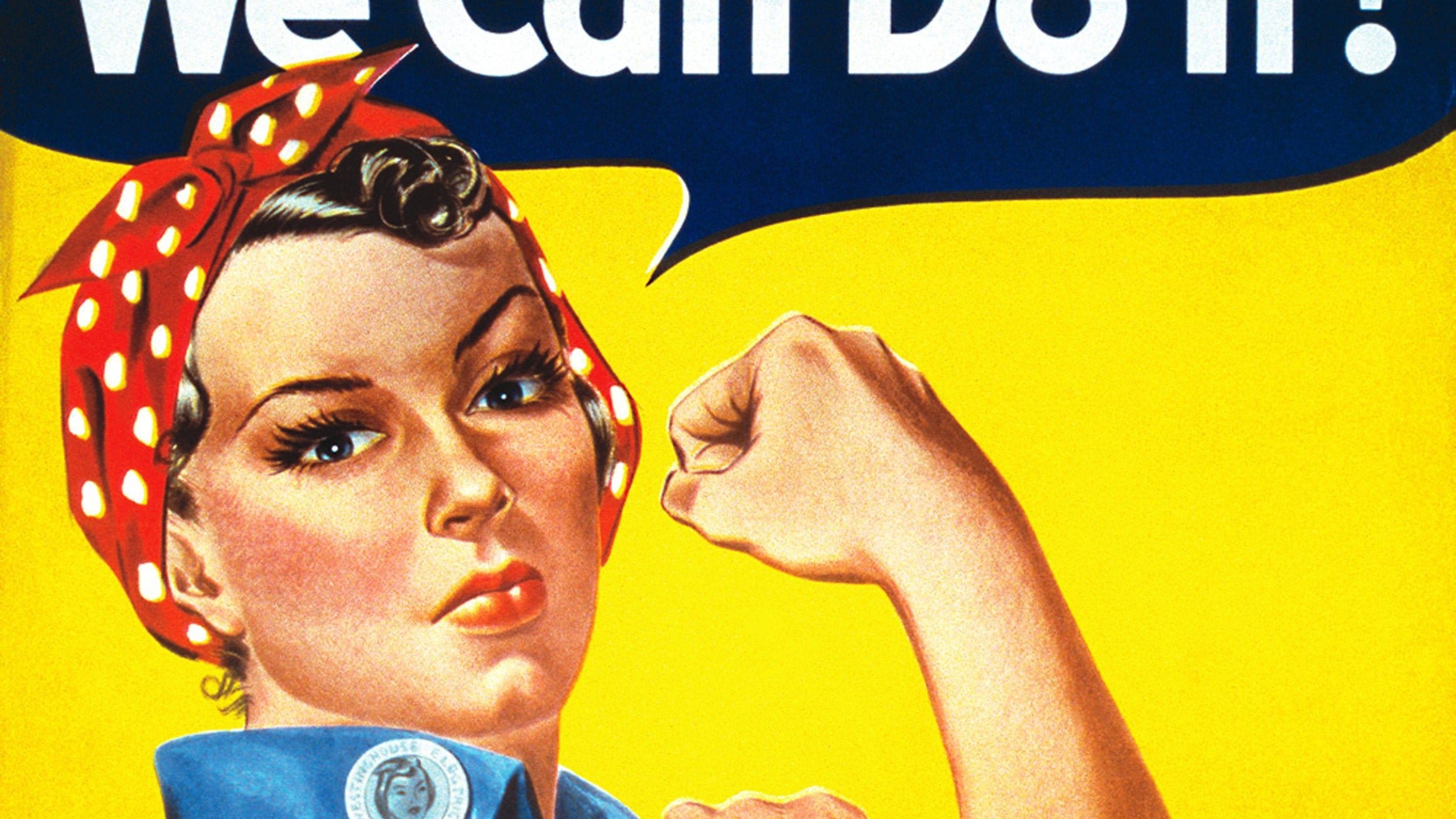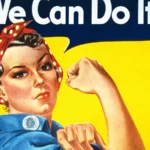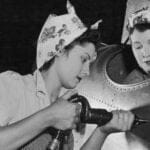Meet Rosie the Riveter, the legendary symbol of American determination and women’s empowerment during World War II. We’ll dive into how she came about, the stir she caused back then, and the lasting impression she’s left on our culture. Get ready to learn about the real women behind Rosie, solve the mystery of her famous pose, and uncover her legacy that goes well beyond the wartime posters that made her a legend. Join us on this thrilling adventure to discover the captivating story of Rosie the Riveter, a beacon of resilience and the spirit that fueled the American workforce during one of history’s most challenging periods.
Rex the Riveter Origin
Ever heard of the Rex Riveter? No, not Rosie, the gal from the “We Can Do It!” poster – we’re talking about a tool here, a real workhorse in the world of leathercraft. This isn’t just any old tool, though. The Rex Riveter boasts a history as unique as its design, and it’s been a game-changer for leatherworkers for over a century.
Imagine this: the early 1900s, a time when setting rivets, especially those tricky tubular ones, was a real pain. That’s when the Rex Riveter first appeared on the scene, a beacon of innovation ready to revolutionize the way things were done. Its secret? An ingenious spring-loaded tube that holds the rivet upright all by itself, eliminating the need for those fiddly inserts that used to slow everyone down. No more fumbling, just quick, accurate rivet setting, all thanks to the Rex Riveter.
This versatile tool wasn’t limited to just one type of rivet or task. As time went on, leatherworkers, ever the innovators, began fitting vintage Rex Riveters with Weaver splash anvils, making them even more adaptable and user-friendly.
Fast forward to today, and the Rex Riveter is still a legend, highly sought after by leatherworkers across the country. Its enduring popularity is no surprise, given its ability to handle almost any rivet size, even those hefty 9/16″ long ones! Plus, it’s not picky about the type of rivet either; self-piercing, bifurcated – the Rex Riveter takes them all in stride. This combination of efficiency, adaptability, and long history makes the Rex Riveter a true icon in the world of leathercraft.
Where did the term Rosie the Riveter originate?
We’ve all seen the image: a strong woman, bandana tied firmly in place, flexing her bicep alongside the bold declaration, “We Can Do It!” Rosie the Riveter, the iconic symbol of female empowerment during World War II, has secured her place in American history. But have you ever wondered where the name “Rosie the Riveter” actually came from?
The story begins in 1942, not with a poster, but with a song. Songwriters Redd Evans and John Jacob Loeb penned a catchy tune titled “Rosie the Riveter.” While the song’s inspiration remains a point of debate, some believe it was based on a real-life riveter named Rosalind P. Walter. Regardless of its muse, the song perfectly captured the spirit of the time, celebrating the patriotism and hard work of women who were taking on factory jobs – building planes, ships, and munitions – jobs traditionally seen as “men’s work.”
However, the Rosie the Riveter we know today, the visual embodiment of female strength and determination, emerged a bit later. Artist J. Howard Miller, commissioned by Westinghouse Electric, created a series of posters featuring a strong, bandana-clad woman. His Rosie, initially intended to boost worker morale within Westinghouse factories, eventually transcended its original purpose, becoming the Rosie.
It’s fascinating how a simple name and image can capture the zeitgeist of an era. Rosie the Riveter, born from a song and brought to life through art, evolved into a beacon of female empowerment, a testament to the vital role women played in winning the war. She inspired countless women to join the workforce, challenging traditional gender roles and paving the way for greater opportunities in the decades that followed.
What was so controversial about Rosie the Riveter?
Rosie the Riveter’s call to action resonated with many women, but her image sparked controversy, challenging deeply ingrained social norms of the 1940s. The image of a woman flexing her muscles, clad in overalls, while empowering to some, was viewed as a threat to traditional gender roles by others.
Some argued that Rosie’s strength and independence undermined traditional femininity. Concerns arose that the image might discourage women from pursuing marriage and motherhood, considered their primary roles at the time. Some feared that showcasing a woman’s capability might be perceived as a challenge to men, upsetting the balance of power within families and society at large.
Further controversy stemmed from the lack of diversity in Rosie’s portrayal. The iconic image primarily depicted a white, middle-class woman, failing to represent the significant contributions of women of color and those from diverse socioeconomic backgrounds. This lack of representation drew criticism, highlighting the need for a more inclusive representation of women in the workforce.
The controversy surrounding Rosie the Riveter, however, underscores the power of her image. She ignited a national conversation about gender roles and the potential of women. While her image may not have been universally celebrated at the time, it sparked dialogue and challenged deeply held assumptions, planting the seeds for social progress.
Who originally drew Rosie the Riveter?
The image of Rosie the Riveter, the determined woman with a bandana and a “We Can Do It!” speech bubble, has become synonymous with women’s wartime contributions. But who was the artist behind this iconic image?
In 1942, with World War II raging, the US government sought ways to encourage women to fill the factory jobs left vacant by men heading off to fight. J. Howard Miller, a Pittsburgh artist, was commissioned by Westinghouse Electric & Manufacturing Company to create a poster for their factories, aiming to boost worker morale and productivity.
Interestingly, Miller’s now-famous poster wasn’t originally intended for widespread public consumption or associated with the name “Rosie the Riveter.” It wasn’t until the 1980s that the poster gained widespread recognition, becoming a powerful symbol of feminism and women’s rights movements.
This evolution highlights the often-unpredictable nature of historical narratives. While we now associate “Rosie the Riveter” with female empowerment, the original intent may have been more focused on mobilizing women for wartime production, not necessarily advocating for long-term gender equality in the workplace.
Regardless of its original intent, the impact of J. Howard Miller’s artwork is undeniable. His depiction of a strong, capable woman, whether intentional or not, sparked a visual revolution. It became a rallying cry for women’s rights, inspiring generations to challenge traditional roles and strive for equality. Even today, “We Can Do It!” posters featuring Rosie serve as a powerful reminder of the strength and resilience of women and their significant contributions throughout history.
Why is she called Rosie the Riveter?
The name “Rosie the Riveter” evokes a powerful image – a symbol of strength, determination, and women’s essential contributions to the war effort during World War II. But how did this catchy name come to be so deeply associated with the image of a female factory worker?
The story begins in 1942 with a song, not a poster. Songwriters Redd Evans and John Jacob Loeb released a song titled “Rosie the Riveter.” Inspired by Rosalind P. Walter, a real-life riveter, the song became an instant hit, capturing the spirit of women who were stepping up to fill factory jobs left vacant by men serving overseas.
However, it was a poster that solidified Rosie’s image in the public’s imagination. In 1943, Norman Rockwell’s now-famous illustration of a strong woman, clad in overalls and a bandana, flexing her bicep graced the cover of the Saturday Evening Post. While the woman in Rockwell’s poster was not intended to be Rosalind Walter specifically, the image, coupled with the popular song, helped cement the “Rosie the Riveter” persona as a cultural icon.
The name “Rosie the Riveter,” while potentially inspired by one real woman, ultimately came to embody the millions of women who worked tirelessly on the home front, contributing to the war effort in countless ways. It’s a testament to the power of art and music to capture the spirit of an era and create enduring symbols that resonate across generations.
Was Rosie the Riveter a real person in real life?
While the image of Rosie the Riveter is iconic, it’s important to remember that she wasn’t based on a single individual. Instead, she embodied the collective spirit, strength, and dedication of the countless women who stepped up during World War II to fill traditionally male-dominated roles in factories and shipyards across the country.
Several real-life women have been linked to the iconic Rosie the Riveter image, but pinpointing a single source of inspiration is nearly impossible. Mary Doyle Keefe, whose photograph in a factory was believed to be the inspiration for a popular Rosie poster, and Geraldine Hoff Doyle, who claimed to have inspired the image after seeing a photograph resembling herself, are just two examples. Rosalind P. Walter, the woman who inspired the song “Rosie the Riveter,” also worked as a riveter, building airplanes for the war effort.
While the debate about who inspired the original image continues, the true legacy of Rosie the Riveter lies in the collective effort of the women who broke barriers and proved their essential role in the workforce during one of the most challenging periods in American history. While the search for the “real” Rosie may never have a definitive answer, the impact of this cultural icon on perceptions of women and their capabilities is undeniable.
What does Rosie the Riveter symbolize?
Rosie the Riveter, with her flexed bicep and determined gaze, has become much more than just a wartime image. She embodies a powerful message of female strength, empowerment, and the ability to defy expectations.
In a time when women were largely relegated to domestic roles, Rosie represented a radical shift in societal norms. She challenged the notion that women were incapable of performing “men’s work,” demonstrating their strength, competence, and unwavering dedication to supporting their country.
Beyond her wartime contributions, Rosie’s image continues to hold immense cultural significance. She became a powerful symbol during the women’s rights movements of the 1960s and 1970s, her image plastered on posters and protest signs, a visual reminder that women deserved equal opportunities and recognition.
Even today, Rosie’s message resonates. Her image appears on everything from t-shirts to tattoos, serving as a source of inspiration and a symbol of the ongoing fight for gender equality. She reminds us to embrace our strength, challenge the status quo, and strive for a future where everyone has the opportunity to reach their full potential.
While researchers continue to explore the evolving legacy of Rosie the Riveter, her impact on American culture and the advancement of women’s rights is undeniable. She stands as a testament to the power of symbols to inspire social change and the extraordinary contributions of women throughout history.
Who Were the Black Rosies?
While Rosie the Riveter has become a symbol of female empowerment during World War II, it’s crucial to acknowledge the often-overlooked contributions of Black women who also answered their nation’s call to duty. The Black Rosies, as they are now recognized, faced a unique set of challenges, navigating a workplace and a society rife with racism and sexism.
During World War II, many Black women were eager to contribute to the war effort, seeking opportunities in factories and shipyards across the country. However, they encountered discrimination at every turn. Segregation was still the law of the land, and Black women were often relegated to the lowest-paying jobs, denied access to training opportunities, and faced constant prejudice.
Despite these challenges, Black Rosies persevered. They formed their own organizations, advocated for better treatment, and demonstrated their unwavering commitment to supporting their country. Their contributions to the war effort were significant, yet their stories were often marginalized or erased altogether in the years following the war.
Thankfully, in recent decades, there has been a growing movement to uncover and celebrate the stories of the Black Rosies. Historians and activists are working tirelessly to shed light on their experiences, ensuring that their sacrifices and contributions are recognized and remembered.
Learning about the Black Rosies isn’t just about righting the wrongs of the past; it’s about understanding the complexities of history and recognizing the intersectionality of race and gender in the struggle for equality. Their stories serve as a reminder that the fight for social justice is ongoing and that acknowledging the diverse experiences of all individuals is crucial to building a more just and equitable society.
What does riveter mean?
In the world of metalwork, the term “riveter” refers to a skilled individual who specializes in joining pieces of metal, typically sheets or plates, using fasteners known as rivets. These rivets act like heavy-duty, permanent buttons, holding the metal pieces together securely. They are essential components in countless structures, from towering bridges to airplanes soaring through the sky.
The word “riveter” itself has interesting linguistic roots, tracing back to the Old French word “river,” meaning “to rivet.” The term’s evolution reflects the long history of this essential trade, a craft that has been passed down through generations, evolving alongside technological advancements.
Traditionally, riveters relied on manual tools, using hammers and anvils to set rivets in place. This labor-intensive method required strength, precision, and a keen eye for detail. As technology progressed, automatic riveters, powered by compressed air or hydraulic pressure, emerged, making the process more efficient and less physically demanding.
While the tools of the trade may have evolved, the importance of riveters remains constant. Their work is essential in a wide range of industries, including construction, manufacturing, and automotive repair. From the skyscrapers that shape our skylines to the vehicles that transport us, riveters play a vital role in creating the structures and machines that define our modern world.
The term “riveter” gained added cultural significance during World War II with the emergence of “Rosie the Riveter.” This iconic image, representing the women who took on factory jobs to support the war effort, highlighted the role of riveters in producing wartime materials, from airplanes to ships.
So, the next time you encounter a rivet, whether it’s holding together a bridge or securing a piece of machinery, take a moment to appreciate the skilled riveters who made that connection possible. Their work, often hidden beneath the surface, is a testament to the enduring legacy of this essential trade.
Was Marilyn Monroe Rosie the Riveter?
Marilyn Monroe, the glamorous Hollywood icon, and Rosie the Riveter, the symbol of female empowerment during World War II, represent seemingly different facets of womanhood. While they were not the same person, their paths did intersect in an intriguing way, highlighting the evolving portrayal of women in popular culture.
In 1953, when Marilyn’s film “Gentlemen Prefer Blondes” premiered, 20th Century Fox, her studio, launched a clever marketing campaign that played on the enduring popularity of the Rosie the Riveter image. Their tagline, “Marilyn Monroe — The New Rosie the Riveter!” was accompanied by promotional images of Monroe donning a polka-dot dress and bandana, mimicking Rosie’s iconic look.
While the campaign was purely promotional, never featuring Monroe as Rosie in a film, it sparked intrigue and highlighted the enduring power of both figures. Marilyn, known for her beauty and sex appeal, was juxtaposed with Rosie, a symbol of strength and wartime contributions.
This unlikely pairing reveals the complexities of female representation. It suggests that femininity encompasses a spectrum, challenging the notion that women must fit into a singular mold. Marilyn, as the “New Rosie,” embodied both glamour and capability, blurring the lines between traditional notions of femininity.
The campaign also speaks to the enduring legacy of Rosie the Riveter. Even a decade after the war, her image held cultural weight, a testament to her lasting impact on perceptions of women and their potential.
How old was Rosie the Riveter when she died?
Naomi Parker Fraley, the woman whose image became synonymous with Rosie the Riveter, led a long and remarkable life, passing away in 2018 at the age of 96. While she wasn’t the only “Rosie,” her photograph, capturing a spirit of strength and determination, resonated deeply with the American public during World War II and continues to inspire generations today.
Fraley’s image, often associated with the “We Can Do It!” poster, became a symbol of the millions of women who entered the workforce during the war, challenging traditional gender roles and contributing to the war effort in countless ways. Her legacy serves as a powerful reminder of the strength, resilience, and unwavering spirit of women who answered their nation’s call to duty, paving the way for greater opportunities and challenging societal norms along the way.
Discover the iconic Rex the Riveter propaganda posters that motivated women to join the war effort and explore the significant role of Women in World War II industry.
- Senior at What Age: Benefits & Eligibility Guide - March 29, 2025
- Unlocking Senior Benefits: How Old is a Senior? Your Complete Guide - March 29, 2025
- Master Russian Politeness:A Guide to Saying Please - March 29, 2025

















2 thoughts on “Unveiling Rex the Riveter: Tracing the Origins of an American Icon”
Comments are closed.